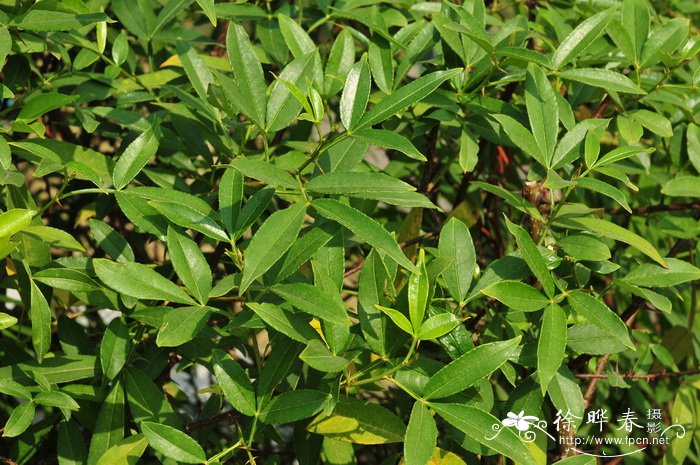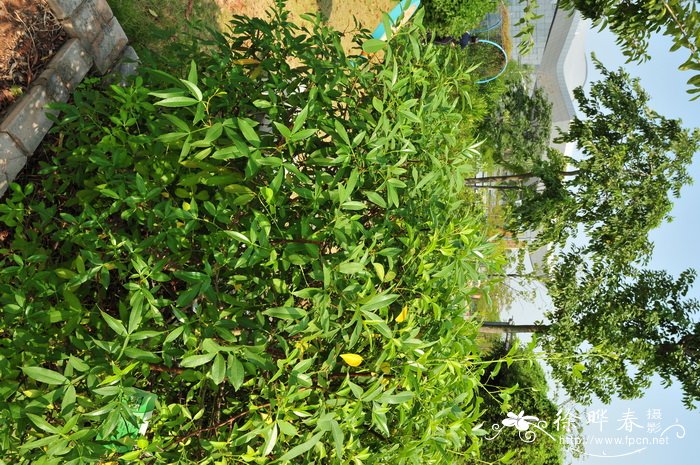竹叶花椒Zanthoxylum armatum
中文名(Chinese Name):竹叶花椒
学名(Scientific Name):Zanthoxylum armatum DC.
英文名(English Common Name):
别名(Chinese Common Name):万花针、山花椒
异名(Synonym):Zanthoxylum arenosum Reeder et S. Y. Cheo Zanthoxylum alatum Roxb. Zanthoxylum alatum var. planispinum (Siebold et Zucc.) Rehder et E. H. Wilson Zanthoxylum alatum var. subtrifoliolatum Franch. Zanthoxylum planispinum Siebold et Zucc. Fagara armata Thunb.
科属(Family & Genus):芸香科(Rutaceae)花椒属
形态特征(Description):高3-5米的落叶小乔木;茎枝多锐刺,刺基部宽而扁,红褐色,小枝上的刺劲直,水平抽出,小叶背面中脉上常有小刺,仅叶背基部中脉两侧有丛状柔毛,或嫩枝梢及花序轴均被褐锈色短柔毛。叶有小叶3-9、稀11片,翼叶明显,稀仅有痕迹;小叶对生,通常披针形,长3-12厘米,宽1-3厘米,两端尖,有时基部宽楔形,干后叶缘略向背卷,叶面稍粗皱;或为椭圆形,长4-9厘米,宽2-4.5厘米,顶端中央一片最大,基部一对最小;有时为卵形,叶缘有甚小且疏离的裂齿,或近于全缘,仅在齿缝处或沿小叶边缘有油点;小叶柄甚短或无柄。花序近腋生或同时生于侧枝之顶,长2-5厘米,有花约30朵以内;花被片6-8片,形状与大小几相同,长约1.5毫米;雄花的雄蕊5-6枚,药隔顶端有1干后变褐黑色油点;不育雌蕊垫状凸起,顶端2-3浅裂;雌花有心皮3-2个,背部近顶侧各有1油点,花柱斜向背弯,不育雄蕊短线状。果紫红色,有微凸起少数油点,单个分果瓣径4-5毫米;种子径3-4毫米,褐黑色。花期4-5月,果期8-10月。
分布(Distribution):产山东以南,南至海南,东南至台湾,西南至西藏东南部。见于低丘陵坡地至海拔2200米山地的多类生境,石灰岩山地亦常见。日本,朝鲜及东南亚也有。
用途(Use):
引自中国植物志英文版:FOC Vol. 11 Page 53, 63
Zanthoxylum armatum Candolle, Prodr. 1: 727. 1824.
竹叶花椒 zhu ye hua jiao| Rutaceae | Zanthoxylum
Shrubs, woody climbers, or trees to 5 m tall, deciduous. Branchlets and leaflet blades abaxially on midvein usually with prickles. Young branchlets and inflorescence rachises glabrous or rust-colored pubescent. Leaves 3-9(or 11)-foliolate; rachis glabrous or rust-colored pubescent, wings to 6 mm on each side; leaflet blades subsessile, opposite, lanceolate, ovate, or elliptic, 3-12 × 1-3 cm, base attenuate to broadly cuneate, secondary veins 7-15 on each side of midvein and generally faint, margin crenate or entire and often revolute when dry, apex acute to acuminate. Inflorescences terminal on short lateral branchlets and sometimes axillary, 1-7 cm, with less than 30 flowers. Perianth in 2 irregular series or 1 series, with 6-8 ± undifferentiated 0.3-1.5 mm tepals. Male flowers: stamens 4-6; anthers yellow prior to anthesis; connective apex with oil gland; disk pulvinate; rudimentary carpels lacking. Female flowers: carpels 2 or 3, abaxially often with a conspicuous oil gland; styles recurved; staminodes ligulate or lacking. Fruit follicles usually purplish red, 4-5 mm in diam., with a few protruding oil glands. Seeds blackish brown, 3-4 mm in diam. Fl. Apr-May, fr. Aug-Oct. 2n = 66.
Found in many habitats; below 3100 m. Anhui, Fujian, S Gansu, Guangdong, Guangxi, Guizhou, S Henan, Hubei, Hunan, Jiangsu, Jiangxi, Shaanxi, Shandong, S Shanxi, Sichuan, N Taiwan, Xizang, Yunnan, Zhejiang [Bangladesh, Bhutan, India, Indonesia, Japan (including Ryukyu Islands), Kashmir, Korea, Laos, Myanmar, Nepal, Pakistan, Philippines, Thailand, Vietnam].
Ohba (Fl. Jap. 22c: 37. 2001) treats the plants from Japan and most of China as Zanthoxylum armatum var. subtrifoliolatum (Franchet) Kitamura.



(责任编辑:徐晔春)
学名(Scientific Name):Zanthoxylum armatum DC.
英文名(English Common Name):
别名(Chinese Common Name):万花针、山花椒
异名(Synonym):Zanthoxylum arenosum Reeder et S. Y. Cheo Zanthoxylum alatum Roxb. Zanthoxylum alatum var. planispinum (Siebold et Zucc.) Rehder et E. H. Wilson Zanthoxylum alatum var. subtrifoliolatum Franch. Zanthoxylum planispinum Siebold et Zucc. Fagara armata Thunb.
科属(Family & Genus):芸香科(Rutaceae)花椒属
形态特征(Description):高3-5米的落叶小乔木;茎枝多锐刺,刺基部宽而扁,红褐色,小枝上的刺劲直,水平抽出,小叶背面中脉上常有小刺,仅叶背基部中脉两侧有丛状柔毛,或嫩枝梢及花序轴均被褐锈色短柔毛。叶有小叶3-9、稀11片,翼叶明显,稀仅有痕迹;小叶对生,通常披针形,长3-12厘米,宽1-3厘米,两端尖,有时基部宽楔形,干后叶缘略向背卷,叶面稍粗皱;或为椭圆形,长4-9厘米,宽2-4.5厘米,顶端中央一片最大,基部一对最小;有时为卵形,叶缘有甚小且疏离的裂齿,或近于全缘,仅在齿缝处或沿小叶边缘有油点;小叶柄甚短或无柄。花序近腋生或同时生于侧枝之顶,长2-5厘米,有花约30朵以内;花被片6-8片,形状与大小几相同,长约1.5毫米;雄花的雄蕊5-6枚,药隔顶端有1干后变褐黑色油点;不育雌蕊垫状凸起,顶端2-3浅裂;雌花有心皮3-2个,背部近顶侧各有1油点,花柱斜向背弯,不育雄蕊短线状。果紫红色,有微凸起少数油点,单个分果瓣径4-5毫米;种子径3-4毫米,褐黑色。花期4-5月,果期8-10月。
分布(Distribution):产山东以南,南至海南,东南至台湾,西南至西藏东南部。见于低丘陵坡地至海拔2200米山地的多类生境,石灰岩山地亦常见。日本,朝鲜及东南亚也有。
用途(Use):
引自中国植物志英文版:FOC Vol. 11 Page 53, 63
Zanthoxylum armatum Candolle, Prodr. 1: 727. 1824.
竹叶花椒 zhu ye hua jiao| Rutaceae | Zanthoxylum
Shrubs, woody climbers, or trees to 5 m tall, deciduous. Branchlets and leaflet blades abaxially on midvein usually with prickles. Young branchlets and inflorescence rachises glabrous or rust-colored pubescent. Leaves 3-9(or 11)-foliolate; rachis glabrous or rust-colored pubescent, wings to 6 mm on each side; leaflet blades subsessile, opposite, lanceolate, ovate, or elliptic, 3-12 × 1-3 cm, base attenuate to broadly cuneate, secondary veins 7-15 on each side of midvein and generally faint, margin crenate or entire and often revolute when dry, apex acute to acuminate. Inflorescences terminal on short lateral branchlets and sometimes axillary, 1-7 cm, with less than 30 flowers. Perianth in 2 irregular series or 1 series, with 6-8 ± undifferentiated 0.3-1.5 mm tepals. Male flowers: stamens 4-6; anthers yellow prior to anthesis; connective apex with oil gland; disk pulvinate; rudimentary carpels lacking. Female flowers: carpels 2 or 3, abaxially often with a conspicuous oil gland; styles recurved; staminodes ligulate or lacking. Fruit follicles usually purplish red, 4-5 mm in diam., with a few protruding oil glands. Seeds blackish brown, 3-4 mm in diam. Fl. Apr-May, fr. Aug-Oct. 2n = 66.
Found in many habitats; below 3100 m. Anhui, Fujian, S Gansu, Guangdong, Guangxi, Guizhou, S Henan, Hubei, Hunan, Jiangsu, Jiangxi, Shaanxi, Shandong, S Shanxi, Sichuan, N Taiwan, Xizang, Yunnan, Zhejiang [Bangladesh, Bhutan, India, Indonesia, Japan (including Ryukyu Islands), Kashmir, Korea, Laos, Myanmar, Nepal, Pakistan, Philippines, Thailand, Vietnam].
Ohba (Fl. Jap. 22c: 37. 2001) treats the plants from Japan and most of China as Zanthoxylum armatum var. subtrifoliolatum (Franchet) Kitamura.
(责任编辑:徐晔春)
踩一下[0]

顶一下[0]